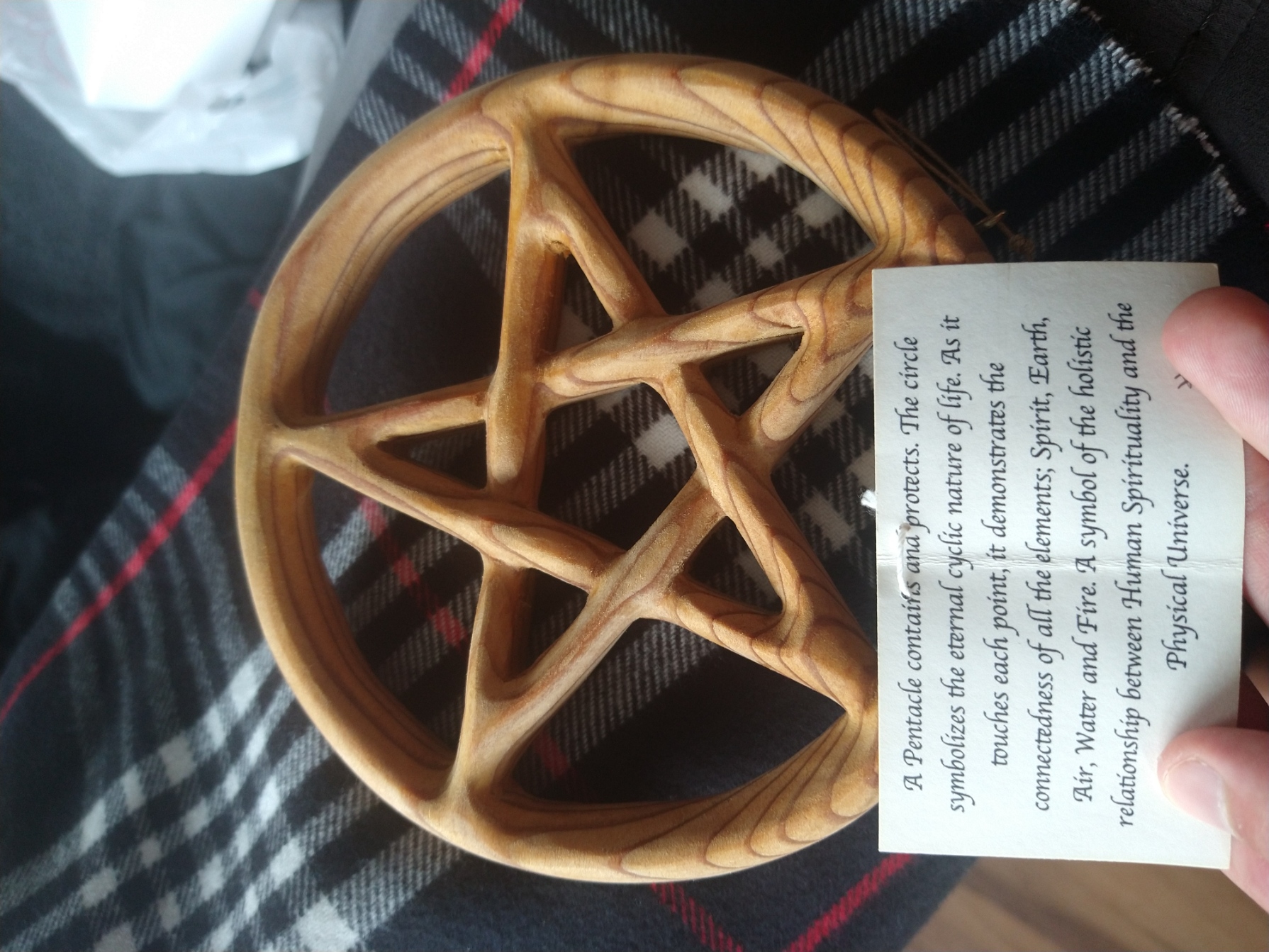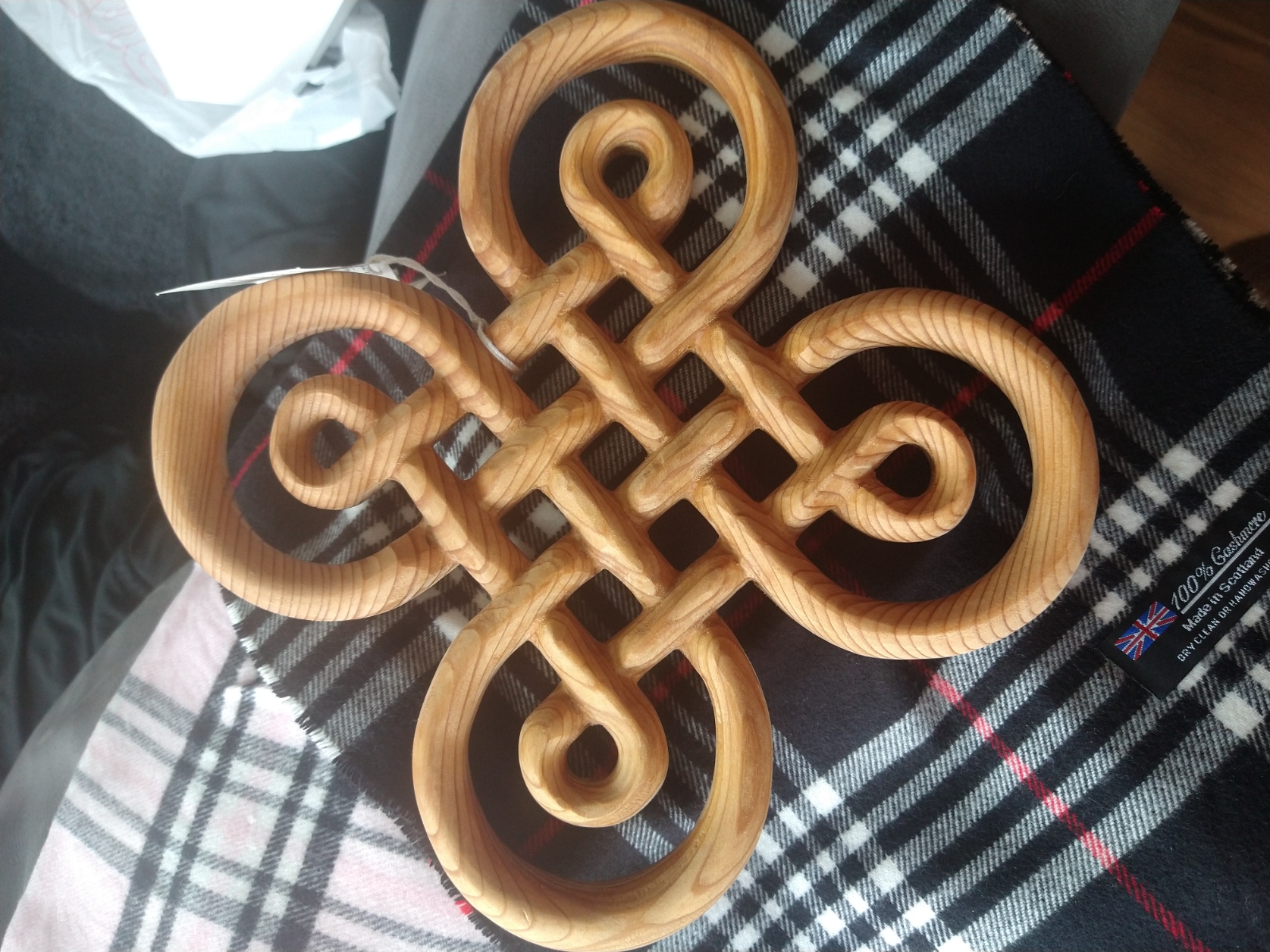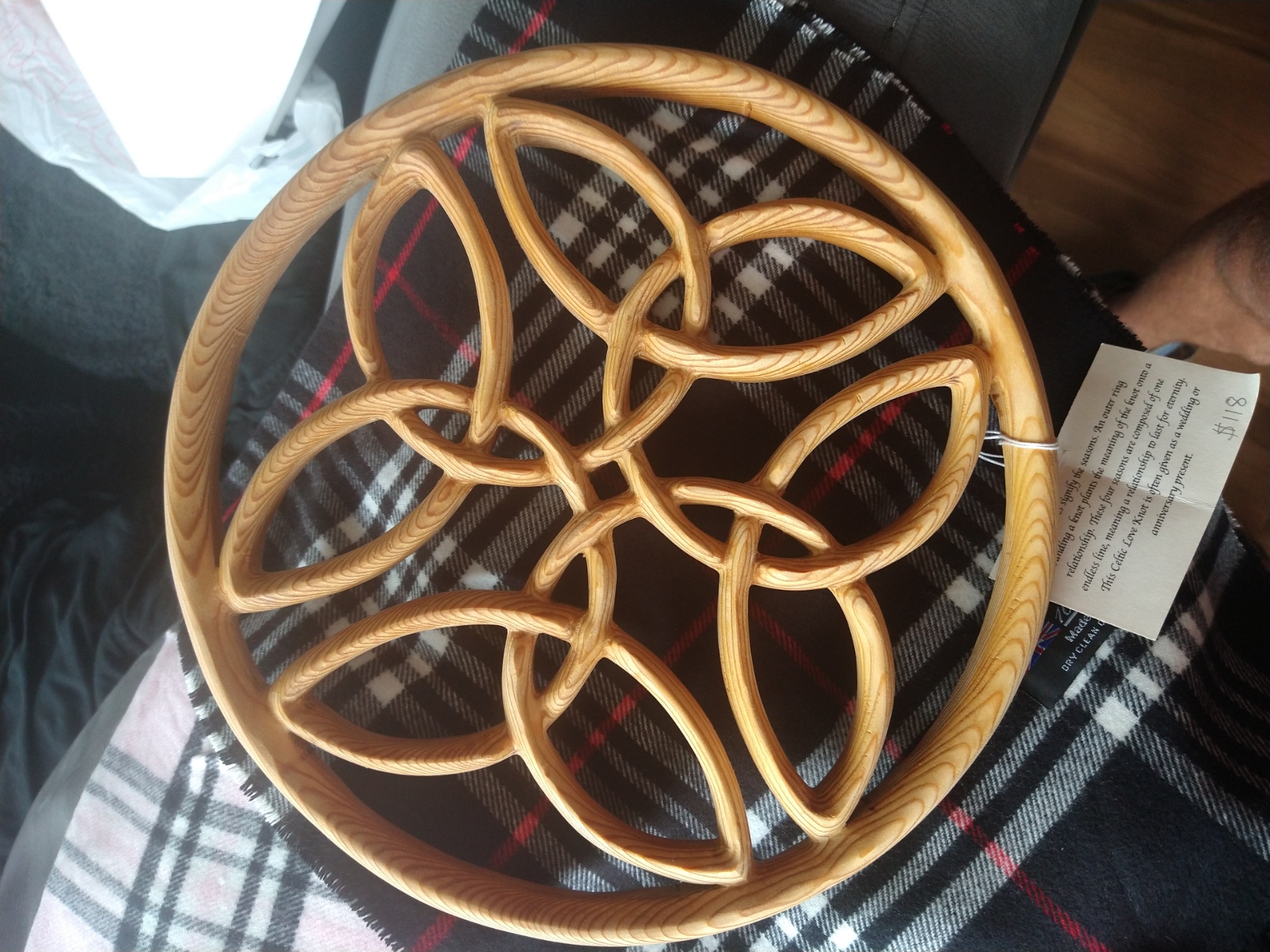Coarse matter can be transfigured in the most wondrous way by the soulful labor of a skilled artisan. Whether wood, stone, metal, fabric or clay they have the uncanny ability to imbue inanimate objects with a spirit they'd never possess absent their shaping hands. I recently perused a number of vendors at the Irish Festival and was impressed by the quality of the artistry, so much so that I ended up buying several pieces. I spoke with a wood worker who had a wide array of symbols carved from cedar, from many different cultures and spiritual traditions. He told me how he and his wife research their meanings so they could include a description on each one that explained the symbolism, which I appreciated. There is great power in an established symbol, above and beyond whatever spiritual quality the artist as an individual imparts to their work. The confluence of the tradition's spirit and the artist's gives rise to a uniquely powerful expression of the meaning.
I bought three pieces from the woodworker, pictured above: a Pentacle, a Knot of Discovery, and a Deleek Knot. The Pentacle, a star in a circle, is described as follows:
"A Pentacle contains and protects. The circle symbolizes the eternal cyclic nature of life. As it touches each point, it demonstrates the connectedness of all the elements; Spirit, Earth, Air, Water and Fire. A symbol of the holistic relationship between Human Spirituality and the Physical Universe."

This aligns pretty well with the meaning of Pentacles in the Tarot tradition, which generally symbolize earthly matters and their relation to spiritual concerns; things like material wealth, socializing, one's position in society, celebrations, bodily health and so on. I personally think of the Pentacle as a sign of material prosperity, bodily vigor and the kind of worldly power that is born of the prolonged exercise of spiritual strength.
The Knot of Discovery, pictured in the middle, was given this description:
"Believed to be an ornamental cross from the Book of Kells, this symbol was found in the ruins of Babylon that predated the Book of Kells by 2,000 years. It is currently used by two international scientific organizations as the Symbol of Discovery..."

The Book of Kells is a manuscript containing the gospels of the New Testament and was made in a monastery somewhere in Scotland or Ireland around 800 AD; its illustrations are richly adorned with colorful Celtic knots. Since discovery or insight is the very heartbeat of spiritual growth I think of this as signifying an increase in understanding, in wisdom. Of the three I bought I find this design to be the most fascinating. The way the various lines interweave with one another is captivating, and the shape as a whole seems to guide your gaze in a ceaseless circuit around the knot. There are 9 openings in the central square and 4 in the outer loops, totaling 13 small openings on the inner portion of the knot. The number 13 is often associated with mystery and death (the thirteenth Tarot card is Death). In this context I think of it as the death which precedes rebirth into a higher state of being. Ultimately this is what discovery or insight is; an old version of ourselves sloughing off and dying so that a new and more refined one can take its place.
Finally, I got a Deleek Knot, pictured on the very bottom. It is described thusly:
"Four circles signify the seasons. An outer ring surrounding a knot plants the meaning of the knot onto a relationship. These four seasons are composed of one endless line, meaning a relationship to last for eternity. This Celtic Love Knot is often given as a wedding or aniversary present."

It's interesting that a love knot would also include a reference to the four seasons. Perhaps it's because relationships, like the climate, go through various stages; sometimes relationships are balmy and blooming as in early spring, other times they're intense, bright and hot like summer, and sometimes they're more pensive, relaxed, chilly and withdrawn as in fall or winter. No relationship is always one way for its entire duration, things ebb and flow, emotions come and go, there is a kind of cyclic dance in play that we can notice if we're attentive. Some people make the mistake of panicking if the emotional tone of their relationship begins to change noticeably; symbolism such as this can help us understand and remember that it's perfectly natural for feelings to change in the course of time. Of course there are good and natural sorts of change as well as ominous and destructive kinds, but change as such is not to be feared. It is inevitable and the very spice of life and love.
I cannot say with certainty the meanings the woodworker and his wife attached to these symbols are accurate, but this is what they've come to mean for me, at least. The Pentacle symbolizes power, the Discovery Knot wisdom, and the Deleek Knot love. It is in the balanced cultivation of wisdom, love and power that a bounteous, beautiful life is found. I now have a symbolic reminder of this fact every time I look upon my wall. I can also remember the conversation I had with the kind old man who made them, and can examine them closely and see the many small passes and adjustments he made in carving them. I can recall the way he spoke so lovingly of his wife, and how much he beamed when he was explaining his work and how he went about creating it. Manufactured items lack this nuance and depth of meaning.
Many people nowadays shy away from artisans because they complain it's "too expensive." Do things made by hand cost more than mass-produced factory products? Yes. These carvings cost far more than some machine-cut wood designs would have. I'm fortunate that I have enough money to buy nice things nowadays. (Believe me, this was not always the case. I lived paycheck to paycheck and barely made rent for most of my twenties.) I actually enjoy paying skilled and passionate artists a fair price for their goods, because I know how much time and effort goes into creating things, and how long and arduous the journey to competence in a given craft can be. Imagine how many years the man I met has refined his woodcarving skills to be able to produce the things he does, and how many hours it might take him to create even one of these carvings. There is something noble and proper in paying someone a higher price when they deserve it. The miserly modernist way of approaching finance is toxic to the real beauty of commerce, and tends to concentrate money and power in the hands of the most cutthroat and soulless merchants, who will always cut corners and vitiate ethics in a bid to get their prices lower and their profits higher. As Franis Bacon once wrote:
"Money is like Muck, not good except it be spread."
Support artisans where and when you can, their contributions are far more valuable than we're inclined to think. Our industrialized world has a dire need of their skills and spirit. A gray and grim materialism shrouds modern symbolism like a thick fog, obscuring everything distant and lofty, everything finely detailed and rich with meaning―mostly simplistic and vulgar creations are produced. Until more people are willing to seek out and support those who trend in the opposite direction this will continue unabated, debasing us all.
